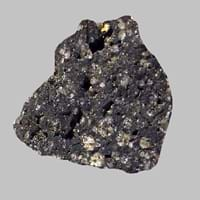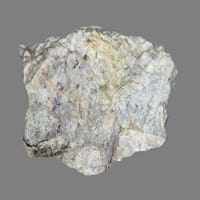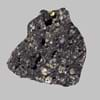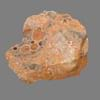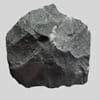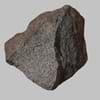Definition
Borolanite is a variety of Nepheline Syenite and belongs to igneous rocks and contains nepheline-alkali feldspar pseudomorphs which occur as conspicuous white spots in the dark rock matrix
Skarns are formed during regional or contact metamorphism and from a variety of metasomatic processes involving fluids of magmatic, metamorphic, and/or marine origin
Origin
Scotland
USA, Australia
Discoverer
Unknown
Tornebohm
Etymology
From Alkalic Igneous complex near Loch Borralan in northwest Scotland
From an old Swedish mining term originally used to describe a type of silicate gangue or waste rock.
Class
Igneous Rocks
Metamorphic Rocks
Sub-Class
Durable Rock, Medium Hardness Rock
Durable Rock, Hard Rock
Group
Plutonic
Not Applicable
Other Categories
Fine Grained Rock, Opaque Rock
Fine Grained Rock, Opaque Rock
Texture
Granular
Earthy, Mud-rich, Rough
Color
Brown, Buff, Cream, Green, Grey, Pink, White
Black, Brown, Colourless, Green, Grey, White
Durability
Durable
Durable
Appearance
Banded and Foilated
Dull
Interior Uses
Countertops, Decorative Aggregates, Flooring, Homes, Interior Decoration
Decorative Aggregates, Entryways, Interior Decoration
Exterior Uses
As Building Stone, As Facing Stone, Paving Stone, Garden Decoration, Office Buildings
As Building Stone, As Facing Stone, Garden Decoration, Paving Stone
Other Architectural Uses
Curbing
Curbing
Construction Industry
As Dimension Stone, Cement Manufacture, Construction Aggregate, for Road Aggregate, Landscaping, Making natural cement, Manufacture of Magnesium and Dolomite Refractories, Production of Glass and Ceramics
As a Flux in the Production of Steel and Pig Iron, As a Sintering Agent in Steel Industry to process Iron Ore, As Dimension Stone, Gold and Silver production, Manufacture of Magnesium and Dolomite Refractories
Medical Industry
Not Yet Used
Not Applicable
Antiquity Uses
Artifacts
Artifacts, Monuments, Sculpture
Commercial Uses
Cemetery Markers
Creating Artwork, Gemstone, Jewelry, Metallurgical Flux, Source of Magnesia (MgO)
Types
Not Available
Endoskarns
Features
Application of acids on the surface causes cloudy frosting, Available in Lots of Colors and Patterns, Dissolves in hydrochloric acid, Is one of the oldest rock
Host Rock for Lead, Zinc and Copper Deposits
Archaeological Significance
Famous Monuments
Data Not Available
Data Not Available
Famous Sculptures
Data Not Available
Data Not Available
Pictographs
Used
Not Used
Petroglyphs
Used
Not Used
Formation
Borolanites are formed due to alkaline igneous activities and are generally formed in thick continental crustal areas or in Cordilleran subduction zones.
Due to change in environmental conditions, rocks are heated and pressurized deep inside the Earth's surface. Skarn is formed from the extreme heat caused by magma or by the intense collisions and friction of tectonic plates.
Mineral Content
Albite, Amphibole, Biotite, Cancrinite, Feldspar, Hornblende, Plagioclase, Pyroxene, Sodalite
Calcite, Enstatite, Epidote, Garnet, Magnetite, Pyroxene, Titanite
Compound Content
Aluminium Oxide, CaO, Iron(III) Oxide, FeO, Potassium Oxide, MgO, MnO, Sodium Oxide, Phosphorus Pentoxide, Silicon Dioxide, Titanium Dioxide
Au, CaO, Carbon Dioxide, Cu, Fe, MgO
Types of Metamorphism
Regional Metamorphism
Burial Metamorphism, Cataclastic Metamorphism, Contact Metamorphism, Hydrothermal Metamorphism, Impact Metamorphism, Regional Metamorphism
Types of Weathering
Chemical Weathering, Mechanical Weathering
Not Applicable
Types of Erosion
Wind Erosion
Not Applicable
Grain Size
Fine Grained
Fine Grained
Fracture
Conchoidal to Uneven
Irregular
Streak
White
Light to dark brown
Porosity
Less Porous
Less Porous
Luster
Greasy to Dull
Waxy and Dull
Compressive Strength
Not Available
Toughness
Not Available
2.4
Specific Gravity
2.6
2.86
Transparency
Translucent to Opaque
Opaque
Density
2.6 g/cm3
2.8-2.9 g/cm3
Specific Heat Capacity
Not Available
Resistance
Heat Resistant, Impact Resistant, Wear Resistant
Heat Resistant
Deposits in Eastern Continents
Asia
Indonesia, Iran, Russia, Saudi Arabia, Sri Lanka, Taiwan, Thailand, Turkey, Turkmenistan, Vietnam
China, India, Russia, Saudi Arabia, South Korea, Sri Lanka
Africa
Angola, Egypt, Madagascar, Namibia, Nigeria, South Africa
South Africa, Western Africa
Europe
Andorra, Finland, France, Great Britain, Italy, Norway, Portugal, Spain, Sweden
United Kingdom
Others
Greenland
Not Yet Found
Deposits in Western Continents
North America
Canada, USA
Canada
South America
Brazil, Chile, Colombia, Uruguay, Venezuela
Brazil, Colombia, Paraguay
Deposits in Oceania Continent
Australia
New Zealand, Queensland, South Australia, Tasmania, Western Australia
Central Australia, Western Australia
Borolanite vs Skarn Characteristics
Though some rocks look identical, they have certain characteristics which distinguish them from others. Characteristics of rocks include texture, appearance, color, fracture, streak, hardness etc. Borolanite vs Skarn characteristics assist us to distinguish and recognize rocks. Also you can check about Properties of Borolanite and Properties of Skarn. Learn more about Borolanite vs Skarn in the next section. The interior uses of Borolanite include Countertops, Decorative aggregates, Flooring, Homes and Interior decoration whereas the interior uses of Skarn include Decorative aggregates, Entryways and Interior decoration. Due to some exceptional properties of Borolanite and Skarn, they have various applications in construction industry. The uses of Borolanite in construction industry include As dimension stone, Cement manufacture, Construction aggregate, For road aggregate, Landscaping, Making natural cement, Manufacture of magnesium and dolomite refractories, Production of glass and ceramics and that of Skarn include As a flux in the production of steel and pig iron, As a sintering agent in steel industry to process iron ore, As dimension stone, Gold and silver production, Manufacture of magnesium and dolomite refractories.
More about Borolanite and Skarn
Here you can know more about Borolanite and Skarn. The life cycle of a rock consists of formation of rock, composition of rock and transformation of rock. The composition of Borolanite and Skarn consists of mineral content and compound content. The mineral content of Borolanite includes Albite, Amphibole, Biotite, Cancrinite, Feldspar, Hornblende, Plagioclase, Pyroxene, Sodalite and mineral content of Skarn includes Calcite, Enstatite, Epidote, Garnet, Magnetite, Pyroxene, Titanite. You can also check out the list of all Igneous Rocks. When we have to compare Borolanite vs Skarn, the texture, color and appearance plays an important role in determining the type of rock. Borolanite is available in brown, buff, cream, green, grey, pink, white colors whereas, Skarn is available in black, brown, colourless, green, grey, white colors. Appearance of Borolanite is Banded and Foilated and that of Skarn is Dull. Properties of rock is another aspect for Borolanite vs Skarn. The hardness of Borolanite is 5.5-6 and that of Skarn is 6.5. The types of Borolanite are Not Available whereas types of Skarn are Endoskarns. Streak of rock is the color of powder produced when it is dragged across an unweathered surface. The streak of Borolanite is white while that of Skarn is light to dark brown. The specific heat capacity of Borolanite is Not Available and that of Skarn is 0.92 kJ/Kg K. Depending on the properties like hardness, toughness, specific heat capacity, porosity etc., rocks are resistant to heat, wear, impact, etc.Borolanite is heat resistant, impact resistant, wear resistant whereas Skarn is heat resistant.
